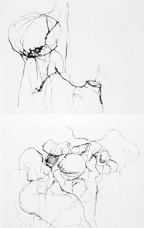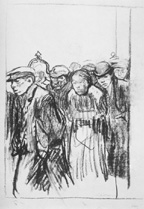|
| Line Quality |
|
 |
|
Range in line quality heightens descriptive potential: you can describe textures, movement, light, space, etc. Using many different kinds of lines in your drawing can also add visual interest. How interesting can a drawing be if everything is the same? Even when the subject or content of a drawing is not readily recognizable, varying line quality can imply space, movement, light, and so on.
Look at the following non-objective or abstract drawings by Philip Guston and Brice Marden... Do you feel a sense of space? Which lines come forward and which recede? How do the artists achieve the push and pull of the drawings' surface?
 |
|
Marden
|
|
|
|
 |
|
Guston
|
|
|
|
|
. |
When the drawing is of a recognizable image, the types of lines you use can add to what you say about your subject matter. This figure drawing by Edward Hopper uses a uniform line in terms of weight (light/dark and thick/thin), but the line is very graceful and smooth. What does the drawing say about the figure?
|
|
 |
|
Hopper
|
|
The type of line and mark also contributes a feeling or mood to the drawing. Does this drawing by Kathe Kollwitz show happy people? What elements in the drawing lead you to read it in a particular way? Consider the types of marks: are they smooth and easy or rough and aggressive?
The character of lines and marks combined with movement/direction helps you construct a complete page, that is, a complete drawing that holds together across the page. Looking at these two landscapes by Rembrandt and Van Gogh, you can see that the direction of lines follows planes of form, including the land. Both artists open up lines, bringing in the white of the page and allowing it to read as space rather than empty page.
 |
|
Rembrandt
|
|
 |
|
Van Gogh
|
|
|
|
 |
|
Kollwitz
|
|
|
. |
Perhaps one of the most direct applications of line quality is the description of textures or surfaces. In this Hopper drawing, look at how he uses different lines to describe different materials: metal vs. rubber vs. glass, etc. Consider also how he brings certain elements forward while others push back. Typically, we see objects closer to us in great detail, meaning that lines will have a greater range in value, thickness, and character in general. Conversely, when see a greater level of detail as evident in line quality, we tend to read that level indicative of a foreground or forward space.
|
|
 |
|
Hopper
|
|
|
|
 |
|
|
|
|
